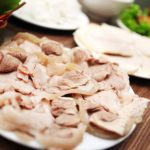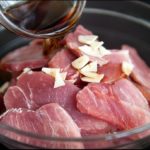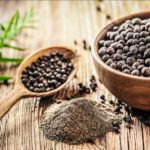Industrial pig meat often uses processed feed, using growth stimulants to reach large weights and exit the barn in a short time, so the meat is bland, watery, not fragrant, and especially has harmful residues that will adversely affect consumer health in the long run. Being raised industrially, these pigs are also more susceptible to disease, so they often have antibiotic residues.
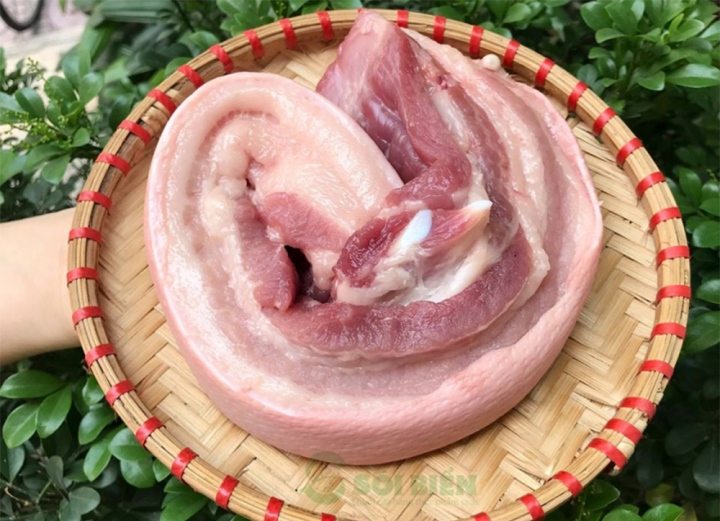
Therefore, even though industrial pork is much cheaper, smart consumers still often choose to buy clean pork, raised in a traditional way, which they often call “home pig”. So how do you differentiate between clean pork and weight-gain pork?
Differentiating between clean pork and weight-gain pork
Clean pork is usually raised for at least 10 months to reach the size of leaving the barn, with low productivity. Therefore, livestock households often focus on industrial pigs, the amount of traditionally raised pork on the market is not much, only meeting the needs of a small part of the population. In the face of the preference for clean pork, ready to bear the high cost of the consumer, many online sellers advertise as “home pig” but sell pigs that have gained weight.
The following tips will help you differentiate between clean pork and weight-gain pork.
Observe the skin and fat: In general, the skin of “home pig” will be whiter and shinier than industrial pork. Traditional raised pigs usually have a layer of fat 2-3 cm thick, with more fat and less lean meat. The layer of fat and the lean meat are tightly attached, with thick skin. Industrial pork has very little fat and thin skin.
Sense of adhesion: When you press your finger into the meat, you will feel that traditionally raised pork is more sticky and the meat is firmer. On the other hand, weight-gain pork usually has less adhesion, the meat is softer.
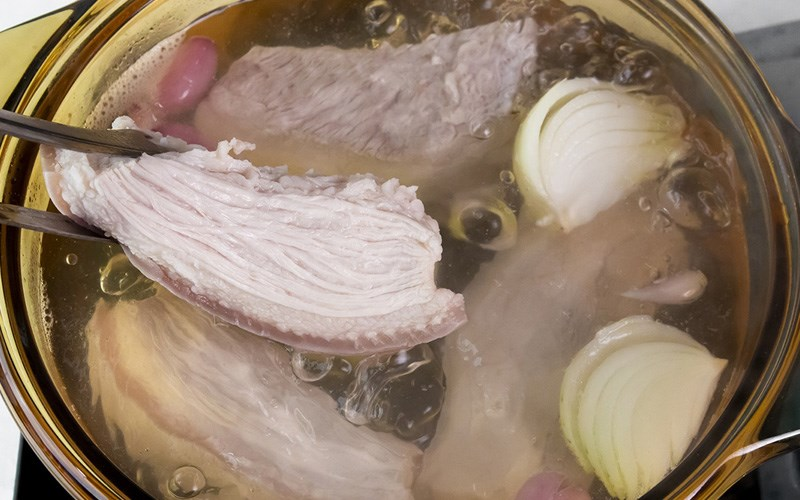
To recognize the difference above, consumers must have a keen sense of perception, and this ability will gradually increase with experience. The more you go shopping, the better you will be able to differentiate between clean pork and weight-gain pork. Once you have bought it, you can also recognize if you have made a mistake during the cooking process, because weight-gain pork will release a lot of water when roasted, stir-fried, with a softer and less fragrant meat. Meanwhile, clean pork will release very little water, with a very attractive fragrance, tender meat, and rich flavor.
Boiling meat correctly
– For the first time, add 1 teaspoon of vinegar, a few thin slices of ginger, and 1/2 teaspoon of salt to the boiling water and then immerse the pork for about 2 minutes, then remove the meat, rinse it again. That way, the meat will not be smelly. The vinegar and salt also help to keep the meat white and clean.
– For the second boiling time, put the meat in the pot right from the beginning, pour enough water, crush a few shallots into the pot, add some spices to make the meat flavorful, and then boil until boiling. Let the meat boil in the pot for 5 to 10 minutes, then use a chopstick to pierce the meat to check if it is cooked thoroughly or not.
The boiling time cannot be accurately determined because it also depends on the size of the meat, thick or thin. If the meat is thick and large, the cooking time may be very long but not necessarily well cooked. In this case, you should use a knife to cut or score the meat to make it easier to cook and not tough.
When boiling meat, if there is foam, it should be removed regularly to keep the meat clean. When you see the fat piece slightly transparent, insert a chopstick through the meat and do not see the reddish liquid flowing out, it means that the meat is cooked. At that time, you can turn off the heat and remove the meat from the pot to drain the water.
– Wait for the meat to cool a bit, then use a knife to slice it into small, bite-sized pieces. Boiled meat should be sliced thin and perpendicular to avoid being tough. Now you just need to arrange the meat on a plate and prepare a delicious dipping sauce to enjoy the tender and fragrant meat.
3 Spices to Limit when Boiling Meat to Preserve Flavor
Are you planning on boiling meat? You should proceed with caution, as 3 popular spices can actually strip away the delicious flavour and scent of your food. Read on to learn why certain spices should be avoided when boiling meat.


























